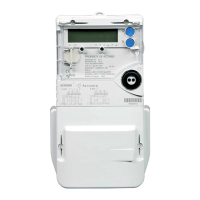7.10.4.5. End of integration (EOI)
The meter can be configured so that up to five different sources can trigger an end of integration period (EOI):
the meter real-time clock
a time change
an active signal on a control input
a change of tariff rate
a power failure
The behaviour of the meter after a power failure is configurable:
Restart
A new integration period starts after power-up.
Resume
The integration period interrupted by power failure is continued after power-up.
Synchronise
The integration period is always synchronised with the next whole hour.
The following illustration shows the three modes of after power failure operation with a block integration period of
15 minutes:
7.10.4.6. Excess demand modes
The meter detects an excess demand when the calculated demand value rises above predefined thresholds for
the current rates. Depending on specific requirements, up to ten excess demand thresholds can be defined.
The meter records the following values for each excess demand:
number of excess demand integration periods
total excess demand duration
cumulated excess demand
Excess demand is indicated by the following methods:
an icon is lit on the meter LCD
a logbook entry and alarm
a switch is activated on a preconfigured control output
Excess demand control can be programmed according to one of the following modes:
Rising demand
Every second, the meter calculates and compares the rising demand value with the demand threshold. If the
demand threshold value is exceeded, the meter immediately indicates an excess. At the end of the current
integration period all excess demand indicators are reset.

